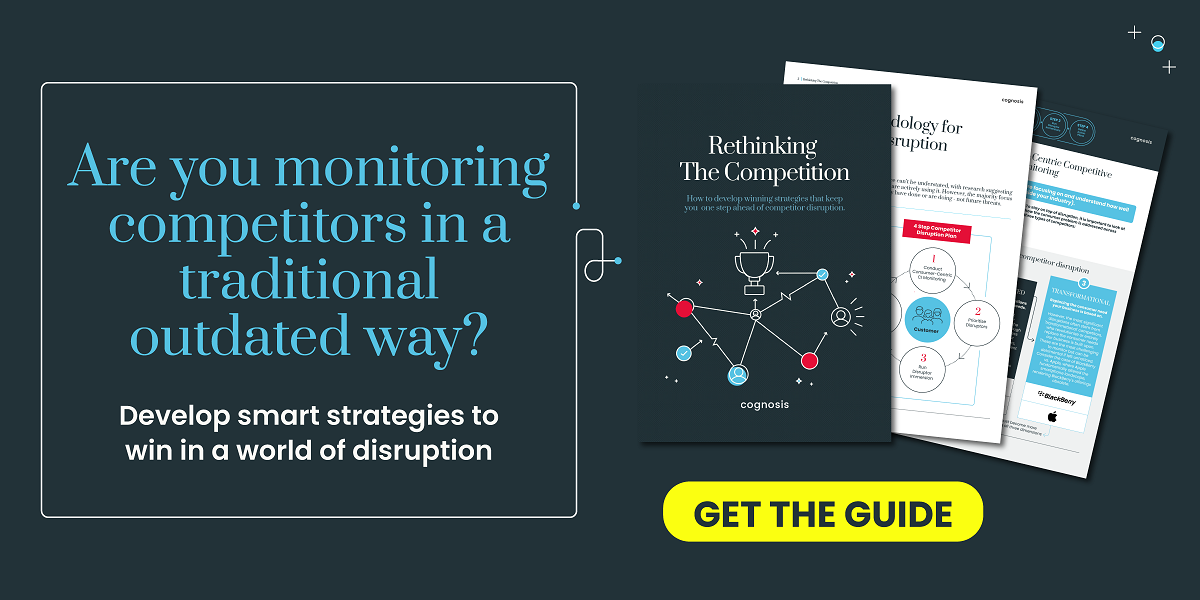4 Key considerations for more effective competitor benchmarking
Your competitor set is changing – but has your approach to competitive benchmarking stayed the same? Pia Kirkland shares four considerations to recalibrate your strategic intelligence and turn insights into meaningful action.

The need for effective competitor benchmarking has risen up the corporate agenda in recent years, due to the growing threat of disruption from start-ups, new business models and technological advancements.
Established companies – and whole industries – are increasingly challenged to adapt in today’s fast-changing landscape if they want to stay relevant in the eyes of their consumers and customers. Ways of thinking that have proved successful over several decades can result in damaging blind spots.
Missed opportunity?
90% of Fortune 500 companies are actively using customer benchmarking to guide their strategic approach. However, the majority focus on direct competition, looking at what they have done or are doing - not future threats.
Turn blind spots into white spaces
Competitor benchmarking (done right) will provide the strategic intelligence your business needs to stay ahead of rivals and market evolution. Over and above comparison, a detailed understanding of competitors will reveal opportunities to innovate and grow. Having clarity on the competitive landscape allows you to isolate white spaces that your business can own, providing a rational view of how to stand out in a crowded market.
> RETHINK YOUR COMPETITION: A practical guide to developing winning strategies that keep you one step ahead of competitor disruption
Scrutinising your rivals will also shine a light on your own business. Ideally, it will confirm your differentiators and strengths, which you can leverage hard. However, it may also expose current weaknesses and gaps that leave you vulnerable to disruption.
Benchmarking can provide a reality check to team members, shattering assumptions and pricking complacency balloons. Nothing defuses a superiority complex quicker than finding out that somebody you underestimated is doing it better.
However, accepting the need to benchmark against competitors is the easy bit. Gathering the right information in a strategic way and then turning insights into meaningful action may require a re-think.
Here are 4 considerations for competitor benchmarking to help beat the odds and thrive in an environment of fierce rivalry:
1. Start with the consumer problem
By putting the consumer problem front and centre, you can investigate who else is looking to solve that problem in the same or different way. However, we often hear a familiar pitfall from clients, ‘If it is not in our market data, it is like it doesn’t exist and it won’t get our attention.’
While scoping out traditional rivals is useful to a degree, it risks overlooking the fragmented nature of current markets and the real risk of new, unforeseen rivals seizing your customer share. Companies need to widen the lens to scan for emerging competitors that are solving the same customer problem by using technology in new ways or introducing an entirely novel business model.
That’s why it’s better to call this competitive rather than competitor benchmarking. You’re forced to think about everyone who could be competitive, rather than those usual suspects next to you at annual trade fairs.
Identifying these incomers early will give you the best chance to defend your position, take inspiration from innovation, form partnerships, make acquisitions and go on the offensive as a disruptor yourself.
Look outside the box
Why not include a business in a different sector who isn’t a competitor, but solves a similar problem better than you? Benchmarking against a gold standard will show where you stand.
2. Be crystal clear on the burning issue
The caveat to Consideration 1 is that you don’t want to benchmark against absolutely everyone, traditional and new. This not only becomes exhausting and time consuming, but you can quickly lose focus without delivering an actionable outcome.
Far better to scope out the strategic questions you need answered and then direct your benchmarking accordingly. It also helps to develop a good contextual understanding of the competitors on your target list, so you can discern why they have made gains or fallen behind.
Ask yourself: Why are we benchmarking, anyway? What do we want to happen afterwards? Without that structure, the exercise will end up being an interesting fact-finding mission, without anything actually changing for the better.
Here are three possible priority areas to keep the process manageable:
- Compare performance: Chart your current strengths and weaknesses in areas such as market share growth, profitability, customer retention and brand equity. Where are you lagging behind? What are they doing better? Without a benchmark, there is no real way to measure success.
- Compare strategic approach: Are your competitors simply more effective at turning their ideas into tangible results? Get under the skin of their business, examining their models, planning and execution style. It always pays to leave the ego at the door and welcome those examples of how your own ability to implement change could improve.
- Compare processes: If a competitor enjoys more successful operations and internal processes, then you may as well learn from their efficiency. At the same time, you could learn that your processes are industry best practice, in which case you can position yourself as a leader with confidence in the eyes of employees, new talent and investors.
3. Invest in high-quality, reliable strategic intelligence
It may sound an obvious statement, but if the competitive intelligence that guides your thinking is inaccurate or biased, then there’s a real risk that your business strategy will take you down the wrong track.
Here’s a few quick pointers:
- Use several sources if possible to cross-reference data. Don’t take one person’s word for it.
- Access publicly available content such as company reports and results, websites, press releases, publications and research. Then double check.
- Tread carefully with automation and Gen AI. Yes, they can monitor a wide breadth of insight and aggregate a variety of online sources, from social media platforms to product reviews. However, they don’t always share their sources.
- Where necessary, raise fresh insight to plug data gaps, using subject matter expert interviews, bespoke reports and mystery shopping.
You need to question your own preconceptions about a rival when gathering intelligence. Imagine it was your company. Would you feel differently about them?
4. Ensure the benchmarking leads to action
The aim for competitor benchmarking is that it leads directly to a business response. Points of action to turn competitor threats into catalysts for growth and transformation might include:
- Collaborate with rivals to unlock mutually beneficial opportunities, such as joint ventures, partnerships, or co-branding initiatives
- Explore acquisition targets to gain access to innovative tech or talent
- Reimagine business models
- Fast-track innovation to rapidly test counter offerings
- Integrate learnings into innovation pipeline and marketing initiatives
- Invest in research and development to stay ahead of emerging trends
Of course, you may choose to do none of the above. That’s the charm of competitive benchmarking. It helps you to be choiceful in your strategic decision making. You’ll gain intelligence on whether it’s best to match the performance of a competitor or beat them at their own game.
Ultimately, when you look at your own consumers/customers – and at your own culture, operating model and mission – you may decide to do something totally different that will catch your competitors by surprise. Now, it’s up to them to respond.
Unlock the full potential of competitive benchmarking
Competitive benchmarking is more than a once-off exercise. Like all big strategic plays, it has the potential to save a company from an existential threat or send it on a fresh growth trajectory.
How well you integrate competitive benchmarking into your strategic processes – rather than use it as a standalone exercise – will determine its long-term benefit. Ideally, benchmarking should be integrated into your regular strategic planning processes. However, if this is a new area for your business, in year one it may run as a distinct project to prove its worth and gain buy-in, before being hardwired into the strategic cadence.
Staying ahead of disruption is a constant battle, which requires unstinting vigilance, smart thinking and strategic foresight. The good news is that competitive benchmarking is well worth the effort. For all those companies that are caught cold by market change, there are plenty more that find a way to thrive amidst disruption, turning competitor challenges into opportunities for success.
> RELATED VIDEO: Industry professionals dicuss their experience at gathering competitive intelligence to navigate disruption.


